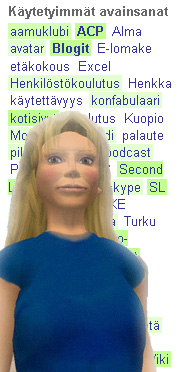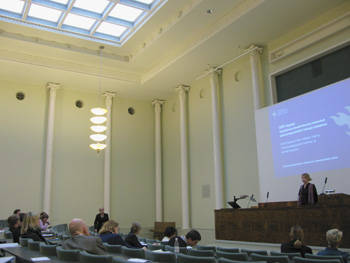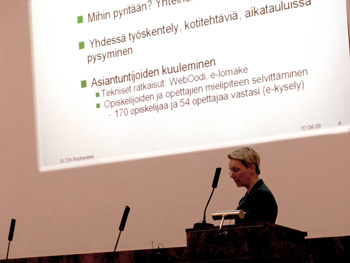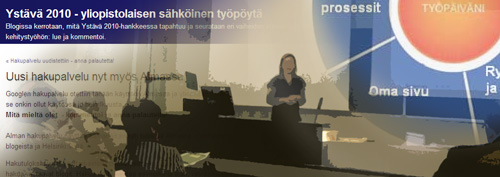Here are some notes from the annual IT-Medi seminar at Meilahti campus, organized by TUKE – the Research & Development Unit for Medical Education at the Faculty of Medicine. The seminar highlights cases where ICT is used in medical education, so of course it’s very close to the field of veterinary medicine as well and therefore highly interesting 😉
Virtual skin care
Docent Anita Remitz (HUS) presented dermatological patient cases she had worked on for the virtual patient case simulator, a slightly game-like self-testing tool that the Faculty of Medicine has built. Cases are usually presented as “Case of the month” -scenarios. In such a scenario, one dermatology case (a fairly easy one) had gotten the right diagnosis from 58% of students in general, and those who had taken the course already had 88% right so apparently education gets under your skin! Oh, and another case contained a photo of late syphilis infection, so now I’ll know how that looks, very helpful!
Of course this is no replacement for real-life practice, but it gives the students more practice than they could get otherwise, as well as getting to see more (rare) types of cases than they would see during the hands-on training period. The virtual patient simulator also helps in educating students in making cost-effective treatments, as more inexperienced students often take a lot of unnecessary tests in order to find the correct diagnosis, but with this tool they can see the actual costs of their treatment and compare it with other students results.
The use of ICT at the Faculty of Medicine
One of the students (a first year student) was there to give the student point-of-view of how ICT is currently used at the faculty. The lowdown: e-mail is used for all communication and therefore encumbered whereas other ways of getting information (like the intranet Alma) aren’t really working because the correct info is hard to find. At least the course material repository DiKK (Digitaalinen kurssikirjasto) is well thought of; all the course materials students need seem to come here on time and are easily found when you know that everything is in one place. No need to “DiKK” around!
My delightful colleagues from the ICT support network, Marja Silenti (ICT planner) and Päivi Heino (National Library of Health Sciences -Terkko) presented a couple of surveys done on the ICT use of both students (http://www.med.helsinki.fi/tuke/tiedostot/raportit/ok_08.pdf) and personnel (http://www.med.helsinki.fi/tuke/tiedostot/raportit/opk_08.pdf) at the faculty. Unfortunately not a lot of personnel participated in the survey whereas the students had been much more active. For the personnel, it seemed that despite all the support available it was the lack of personal time required to learn new ICT tools that was the biggest obstacle to try out new educational tools.
Marja also gave a quick presentation on the different ICT tools currently offered at the university, and had chosen the tools presented based on the tag cloud in her blog – a nice touch, which worked well (see picture above)!
These teeth are okay, those kids’ bones aren’t
Antti Kämppi, dentist and teacher presented the latest version of the Clinipoint-system (now called something else) he had been involved in designing and which won the “Learning technology” award in 2008 [ok.helsinki.fi]. It is basically a system using RFID-tags [wikipedia.org] to authenticate teachers so they can electronically approve and sign student achievements – apparently a cumbersome process during the dentist training stage requiring lots of handwriting otherwise – a few thousand signatures per student, in fact. I suppose any automation of monotone administrative tasks is always welcome.
Interestingly enough there seemed to be quite a lot of initial resistance amongst teachers when introducing the system. The development process also seemed to depend a lot on Mr. Kämppis personal contacts, otherwise it could have been a much more costly project than it was now. Getting cheap but good quality custom software is always a challenge.
The busy & cheerful doctor Mikko Mattila (HUC) presented his Moodle quiz on Pediatric Orthopaedics, a field that apparently students’ didn’t get that much time to spend with (approx. 3 weeks in total). We got to do one of the multiple choice quizzes collaboratively. Surprisingly enough it seemed that the relatively small x-ray pictures the quiz was based on provided sufficient information to work with – analyzing x-ray pictures is something I’ve always considered next to impossible even with large screens. The quiz certainly wasn’t easy – the questions drilled us on how fractures should be treated and how successful the surgery had been. Designing good questions is of course the biggest challenge, as the participants in this course had varying proficiency levels (lots of students from other medical districts). And, apparently the way of giving automatic feedback from the quiz wasn’t one of Moodle’s strengths, so there always seems to be compromises to be made with the tools these learning environments offer.
Links:
TUKE (Research & Development Unit for Medical Education)
http://www.med.helsinki.fi/tuke/
Virtual patient case simulator
http://www.med.helsinki.fi/tuke/palvelut/vpp.htm
Digitaalinen kurssikirjasto (DiKK)
http://oma.terkko.helsinki.fi:8080/~dikk


 One of my duties as an e-learning planner is working on the faculty’s feedback system, especially the part concerning electronic means of collecting and storing student course feedback (which we collect mostly with
One of my duties as an e-learning planner is working on the faculty’s feedback system, especially the part concerning electronic means of collecting and storing student course feedback (which we collect mostly with 
